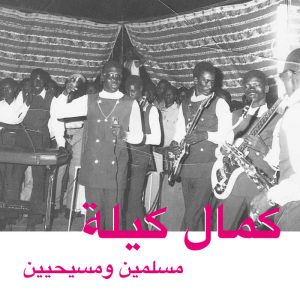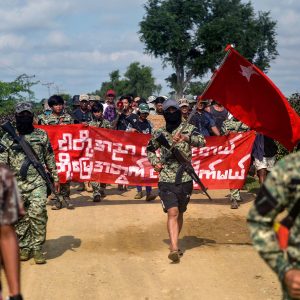On July 18, world news spread as an Egyptian Court sentenced Coptic Egyptian human rights advocate, Patrick Zaki, to three years of prison for “spreading false news.” After 22 months of pre-trial detention, Zaki was reported to have suffered from physical and mental torture during his time in Egypt. Airport security detained him following his arrival to his homeland for a short break from his graduate studies at the University of Bologna, Italy. A few months before, Zaki published an article, “Forced Migration, Murder, and More: A Week in the Life of Egypt’s Copts,” on Daraj, and touched on a hidden iceberg of persecution and discrimination against Coptic Christians in Egypt. Was it not for Italian and European pressure for his release, he would have gone unaccounted for like many others. Although Zaki was pardoned, millions remain harmed under the scrutiny of institutional discrimination, kidnapping, forced conversion, looting, and murder.
Copts are not the only minority to face outright discrimination and ethnic cleansing. In 2013, a radical Sunni group burned a Shiite family house and lynched four men, citing their “heresy” for their murder. Earlier in 1950, after the fall of the Egyptian monarchy, more than hundreds of thousands of Egyptian Jews were expelled from Egypt with a on-way visa shortly after Egypt’s defeat in the First Arab-Israeli War. “We will show you the anger. We will show you what terrorism actually looks like,” is what numerous radical Islamists left, and continue to leave, on the walls of churches and Coptic houses and businesses since 639 AD.
Today, after unapologetically persecuting Copts throughout the last two millennia, the current government and extreme religious and social sects have switched a slower, more unpredictable pattern of discrimination that, should any political conflicts arise like the ones that took place in the last decade, minorities in Egypt, including the Coptic people, may be facing acts of full-scale genocide.
Who Are The Copts?
The Coptic people are an ethnoreligious population that identifies as the descendants of ancient Egyptians, according to their genetic results and the evolution of their language and traditions that root back to the ancient Egyptian civilization. After the Christianization movement in around 60 CE by Mark the Evangelist (known to the Copts as the first Patriarch of the Coptic Orthodox Church), the Church of Alexandria became an intellectual center for the ancient world and a leader in theology and the sciences.
The term Copt literally and historically refers to the native population of Egypt, yet in the last four centuries, the term started referring to Egyptian Christians, predominantly members of the Coptic Orthodox Church, due to the state’s Arabization efforts. There are around 15 million Copts in Egypt and two million abroad and they make up less than 1% of the Libyan and Sudanese population.
In 639 CE, ‘Amr ibn al-‘As initiated his first Arab invasion of Egypt after a series of conquests in the Levant. After years of siege and surrender, the Byzantine governor and al-‘As settled on the Treaty of Alexandria, which included the establishment of the jizya, grant of autonomy of Copts and Jews in Egypt, and guarantee of no Muslim intervention in church affairs should the Copts not support a new Byzantine invasion. The new Arab administration, however, breached this contract as their primary compliance was to the Pact of Umar, a document 4-5 years older than the Treaty. Throughout the different dynasties, Arab leadership treated the Coptic population with various amounts of discrimination that started from radical increases in taxes and up to full-scale massacres. With much of the native population converting to Islam to waive the jizya and dhimmi status, the word Copt transformed to define the native population that has not converted to Islam. With the central theme in the unity of all Muslims as one umma, the term Copt started limiting itself to Egypt’s native Christians.
At the peak of Coptic autonomy, in 1911, Coptic leaders from Asyut urgently called for the Congress to be held and change its mission from internal reformations to advocating for equal citizenship for all Copts. For the first time, in March 1911, 1,150 representatives convened to represent the Copts from all across the nation. The congressional body incorporated individuals from all Christian denominations and high-ranking members of the Congress were required to not be senior government officials to prevent the traditional archons’ conflict of interest. Although the Congress’ demands seem decently appropriate even in this historical context, especially with the emerging secularization trend in the Ottoman Empire, the developing pressing powers backfired those demands to destroy the yet best example of Coptic autonomy. A month later, the Islamic Congress – later renamed the Egyptian Congress – convened to refuse the five demands. The Congress leader proclaimed that those demands did not meet the nationalist vision of political unity under the indivisible state religion, Islam. The idea of a state religion was hence born from this convention.
After the abolition of the monarchy in 1952, the first two presidents, both supporters of the Muslim Brotherhood, established a dictatorial regime that heavily depended on military power and censorship. One of the biggest visions adopted by Gamal Abdel-Nasser, and later by all other presidents, is Arab nationalism, which ignited hatred and discrimination against Copts, whom many saw as the non-Arabs who follow the colonizers’ faith. This idea was the latest attempt to alienate the Copts from their motherland and, eventually, systemically transform their perceived identity from the Christian indigenous population to the heretic foreigners.
Individual Cases or Systemic Targeting?
Experts in the Middle East have not agreed on the Copts’ status in Egypt and how to define it. Alas, the narrative coming from the Copts has been very conflicting at times, which mainly comes from the lack of proper, official representation for all of the population. For instance, the Coptic Orthodox Patriarch, Tawadros II, has repeatedly come out to praise the current regime and its treatment of its indigenous population. While human rights organizations and international institutions, like Coptic Solidarity, Amnesty International, and the European Parliament, have repeatedly exposed violations by the government, the latter has actively sought to alter the narrative, even by sending religious leaders to lobby for the US government. Clearly, the national regime has consistently adopted three main tools to change the facts and distort the truth: denial, legal manipulation, and forced tolerance.
Nationally, there have been numerous trends that reflect that pattern of discrimination. For example, adding a religious affiliation to identification documentation has been a central symbol of discrimination in Egypt. The only three options for this section are Muslim, Christian, and Jewish. The ID cards are usually presented to every aspect of life: healthcare, military service, university enrollment, and more everyday agencies. It is also impossible for anyone to convert from Islam, especially with the 2008 Court ruling that banned legal conversion from Islam. The law to license church buildings, too, violates the right to establish and maintain places of worship set by the Declaration on the Elimination of All Forms of Intolerance and of Discrimination Based on Religion and Belief, the International Covenant on Civil and Political Rights, and the African Charter on Human and Peoples’ Rights. According to the U.S. State Department’s International Religious Freedom Report for 2018, the Church Regularization Committee approved less than 20% of the applications for Christian religious buildings. On the other hand, tens of churches close annually due to the bureaucratic, lengthy licensing process, and such problems often lead to sectarian attacks. Despite all this, the Al-Nour Party, a political-religious party (which is considered illegal under Article 74 in the Egyptian Constitution), considers this law as an undeserved, un-Islamic privilege to Christians. Although Article 63 prohibits the forced migration of all citizens, Soad Thabet, 74, and her husband were forced out of her village after she was assaulted and stripped naked by three men who believed that her son was in a relationship with a Muslim woman. Within six years of court proceedings, the three accused were acquitted multiple times, and Thabet now faces a civil compensation suit. The courts have proven to be ineffective in ruling in sectarian incidents as, according to a study, 45 of these are decided by customary reconciliation sessions. These sessions are usually biased against the Christian side, and a common result of them would be the forced migration of the Christian family. As per the international statutes that grant the right for minorities’ participation in national decisions, Coptic representation has been radically disproportionate if not absent. Out of the 100 vice-residents of the State Council that were appointed by Presidential Decree 12, only one of them was a Copt. Out of the 516 deputy persecutors that the President appointed in September 2022, five of them were Copts. There are almost no Copts among all university administrators, and that applies to all 98 newly appointed female judges, national sports teams, government posts, or any other discipline. In fact, in almost all areas, Copts represent an average of 0-2% of public posts in Egypt.
Throughout the last decade, hundreds of Coptic minor females have been kidnapped, raped, and forcibly converted to Islam. Under only one priest’s jurisprudence, about 15 girls are kidnapped and coercively converted and married annually. The systematic and practical mental and physical harm as well as the forcible conversion of children comes in direct violation of the UN Convention on the Rights of the Child; The Protocol to Prevent, Suppress and Punish Trafficking in Persons Especially Women and Children, supplementing the United Nations Convention against Transnational Organized Crime; The Trafficking Victims Protection Act of 200; Article 10 of The Arab Charter on Human Rights; Article 3 of Egyptian Law Number 64 of 2010 on Human Trafficking; and most dangerously Article 2 of the Convention on the Prevention and Punishment of the Crime of Genocide.
Additionally, the “blasphemy law” has been a major human rights concern in Egypt for years as it severely limits freedom of thought and expression. A deeper, more unannounced concern is the disproportionality and execution of the law that authorities have been using to particularly limit discrimination against Christian Copts. In a study by Tahrir Institute of Middle East Policy’s Eshhad, 41% of all recorded blasphemy cases are against Christians. Of the 36 blasphemy cases made between 2011 and 2012, 35 were made for blaspheming Islam, and the only one against Christianity was dismissed. This law has been abused by authorities and religious officials to prohibit any evangelical activity or any comments on the Islamic State. These charges have not decreased since the removal of former President Muhammad Morsi, but are used continuously against advocates, activists, and evangelists.
Where do the Copts go from here?
In a post-Muslim Brotherhood state, the Copts have been officially living in a time of prosperity and safety. When this relativity rules out short-term terrorism and extermination, it is nowhere near enough to grant long-lasting equality and safety for Copts. With the rise of a one-man rule and the existing tensions in the region, the Egyptian government has fostered an environment where sectarian and ethnic tension can easily evolve just like how it happened in Rwanda, the Ottoman Empire, or the German Reich. That is not to say that Copts are facing the imminent threat of genocide as the public has known it from the twentieth-century crimes, but it might be time to explore the Copts’ fitting of the Genocide Convention’s classification.
Featured Image Source: The Atlantic






Comments are closed.